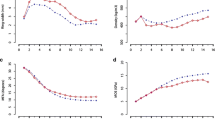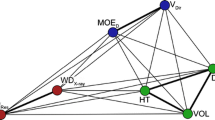Abstract
Douglas-fir trees from 39 open-pollinated families at four test locations were assessed to estimate heritability of modulus of elasticity (MOE) and basic density. After trees were felled, sound velocity was measured on 4-m logs with the Director HM200. Disks were taken to estimate dry and green wood density; dynamic MOE was estimated as green density × (sound velocity)2. Heritability estimates of MOE (across-site h 2=0.55) were larger than those for total height (0.15) and diameter at breast height (DBH; 0.29), and similar to those for density (0.59). Negative genetic correlations were found for MOE with height (r A=−0.30) and DBH (r A=−0.51), and were similar to those found for density with height (r A=−0.52) and DBH (r A=−0.57). The partial correlations of height with MOE and density, while holding DBH constant, were positive, implying that the observed negative correlations between height and the wood properties were a function of the high positive correlation between height and DBH and the strong negative correlations between DBH and the wood properties. Taper [DBH/(height−1.4)] was found to be negatively associated with MOE. Selection for MOE may produce greater gains than selection for density because MOE had a larger coefficient of additive variation (9.6%) than density (5.1%). Conversely, selection for growth may have a more negative impact on MOE than density because of the greater genetic variation associated with MOE. Family mean correlations of the wood quality traits with stem form and crown health were mostly nonsignificant.


Similar content being viewed by others
References
Alden HA (1997) Softwoods of North America. Gen. Tech. Rep. FPL-GTR-102. US Department of Agriculture, Forest Service, Forest Products Laboratory, Madison, p 151
Andrews M (2002) Wood quality measurement-son et lumière. N Z J For 47(3):19–21
Bastien JCh, Roman-Amat B, Vonnet G (1985) Natural variation of some wood quality traits of coastal Douglas-fir in a French progeny test: implications on breeding strategy. IUFRO S2.02.05 Working Party, Vienna, June 1985
Becker WA (1984) Manual of quantitative genetics, 4th edn. Academic, Pullman, p 190
Burdon RD (1977) Genetic correlation as a concept for studying genotype–environment interaction in forest tree breeding. Silvae Genet 26:168–175
Burdon RD, Low CB (1992) Genetic survey of Pinus radiata. 6. Wood properties: variation, heritabilities, and interrelationships with other traits. N Z J For Sci 22(2/3):145–228
Campbell RK (1979) Genecology of Douglas-fir in a watershed in the Oregon Cascades. Ecology 60(5):1036–1050
Cave ID, Walker JCF (1994) Stiffness of wood in fast-grown plantation softwoods: the influence of microfibril angle. For Prod J 44:43–48
Forest Products Laboratory (1999) Wood handbook—wood as an engineering material. Gen. Tech. Rep. FPL-GTR-113. US Department of Agriculture, Forest Service. Forest Products Laboratory, Madison, p 463
Johnson GR (1997) Site-to-site genetic correlations and their implications on breeding zone size and optimum number of progeny test sites for coastal Douglas-fir. Silvae Genet 46:280–285
Johnson GR (2002) Genetic variation in tolerance of Douglas-fir to Swiss needle cast as assessed by symptom expression. Silvae Genet 51:80–86
Johnson R, Jayawickrama K (2002) Genetics of wood specific gravity in coastal Douglas-fir. In: Jayawickrama K (ed) Proceedings of the Workshop Genetic Improvement of Wood Quality in Coastal Douglas-fir and Western Hemlock, Corvallis, 27 June 2002, pp 43–49. http://www.fsl.orst.edu/pnwtirc/publications/Electronic version of some pubs/Jayawickrama, Bracher & Howe (2002) (WQ).pdf
Johnson GR, Gartner BL, Maguire D, Kanaskie A (2003) Influence of Bravo fungicide applications on wood density and moisture content of Swiss needle cast affected Douglas-fir trees. For Ecol Manag 186:339–348
Johnson GR, Grotta AT, Gartner BL, Downes G (2005) Impact of the foliar pathogen Swiss needle cast on wood quality of Douglas-fir. Can J For Res 35:331–339
Jozsa LA, Middleton GR (1994) A discussion of wood quality attributes and their practical implications. Special Pub. No. SP-34. Forintek Canda Corp, Vancouver, p 42
King JN, Yeh FC, Heaman JCH (1988) Selection of wood density and diameter in controlled crosses of coastal Douglas-fir. Silvae Genet 37:152–157
Knowles L, Hansen, Downes G, Kimberley M, Gaunt D, Lee J, Roper J (2003) Modelling within-tree and between-tree variation in Douglas-fir wood and lumber properties. In: Proceedings of IUFRO All Division 5 Conference, Rotorua, 11–15 March 2003, pp 87–100
Kumar S (2004) Genetic parameter estimates for wood stiffness, strength, internal checking, and resin bleeding for radiata pine. Can J For Res 34:2601–2610
Kumar S, Jayawickrama KJS, Lee J, Lausberg M (2002) Direct and indirect measures of stiffness and strength show high heritability in a wind-pollinated radiata pine progeny test in New Zealand. Silvae Genet 51:256–261
Littell R, Miliken G, Stroup WW, Wolfinger RD (1996) SAS system for mixed models. SAS, Cary
Loo-Dinkins JA, Gonzalez JS (1991) Genetic control of wood density profile in young Douglas-fir. Can J For Res 21:935–939
Megraw RA (1986) Douglas-fir wood properties. In: Oliver CD, Hanley DP, Johnson JA (eds) Proceedings of the Douglas fir: stand management for the future conference, College of Forest Resources, University of Washington, Seattle, 18–20 June 1985, pp 81–96
Pellerin RF, Ross RJ (2002) Nondestructive evaluation of wood. Forest Products Society, Madison, p 210
Searle SR (1961) Phenotypic, genetic and environmental correlations. Biometrics 17:474–480
Sokal RR, Rohlf FJ (1995) Biometry: the principles and practice of statistics in biological research, 3rd edn. WH Freeman, New York, pp 643–649
Squillace AE (1974) Average genetic correlation among offspring from open-pollinated forest trees. Silvae Genet 223:149–156
St Clair JB (1994) Genetic variation in tree structure and its relation to size in Douglas-fir. I. Biomass partitioning, foliage efficiency, stem form and wood density. Can J For Res 24:1226–1235
Stonecypher RW, Piesch RF, Helland GG, Chapman JG, Reno HJ (1996) Results from genetic tests of selected parents of Douglas-fir (Pseudotsuga menziesii (Mirb.) Franco) in an applied tree improvement program. For Sci Monogr 32:1–35
Vargas-Hernandez J, Adams WT (1991) Genetic variation of wood density components in young coastal Douglas-fir: implications for tree breeding. Can J For Res 21:1801–1807
Woods JH (1993) Breeding programs and strategies for Douglas-fir in North America. In: Park YS, Adams GW (eds) Breeding strategies of important tree species in Canada. N.B. Inform. Rep. no. M-X-186E. Natural Resources Canada, Fredericton, pp 1–11
Yamada Y (1962) Genotype by environment interaction and genetic correlation of the same trait under different environments. Japan J Genet 37:498–509
Acknowldegements
This research was supported by the Sustainable Forestry component of Agenda 2020 (a joint effort of the US Department of Agriculture Forest Service Research and Development and the American Forest and Paper Association), a special grant from the USDA to Oregon State University for wood utilization research, the Swiss Needle Cast Cooperative, and the Oregon Department of Forestry. Data and analyses were also provided by the Northwest Tree Improvement Cooperative. Field assistance was provided by Steve Skinner and Joe Travers of the Oregon Department of Forestry and the chainsaw crew from the Oregon Department of Corrections. Nicole Suty helped with some of the measurements. Helpful reviews were provided by Rowland Burdon, Marilyn Cherry, Keith Jayawickrama, Leith Knowles, Satish Kumar, Nancy Mandel, Charles Sorensson, Michael Stoehr, and three anonymous reviewers.
Author information
Authors and Affiliations
Corresponding author
Additional information
Communicated by S. Aitken
Rights and permissions
About this article
Cite this article
Johnson, G.R., Gartner, B.L. Genetic variation in basic density and modulus of elasticity of coastal Douglas-fir. Tree Genetics & Genomes 3, 25–33 (2006). https://doi.org/10.1007/s11295-006-0054-0
Received:
Revised:
Accepted:
Published:
Issue Date:
DOI: https://doi.org/10.1007/s11295-006-0054-0




